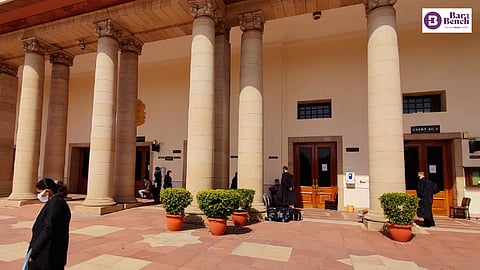
- Latest Legal News
- News
- Dealstreet
- Viewpoint
- Columns
- Interviews
- Law School
- Legal Jobs
- हिंदी
- ಕನ್ನಡ

Legal practice, though bound by the black-and-white dress code, unfolds in countless shades. Over the past two decades, I have observed many nuances of this profession, but one experience remains common to every Supreme Court practitioner; something that shapes our weekends, tests our nerves and defines the rhythm of the courtroom - the pressure of Item One.
A typical Monday in the Supreme Court begins with a long cause list of 50 to 60 matters lined up for the day. The courtroom is a familiar setting: a common dais, judges on one side, lawyers on the other, and an air of anticipation as the day’s proceedings commence. But regardless of how many cases are listed, one truth remains - Item One is always Item One.
Being the first matter of the day, it carries immense responsibility. It is the opening act, the case that sets the tone for the entire day. The judges may feel the pressure of starting the judicial engine, but for the advocate arguing Item One, the burden is particularly intense.
Preparation begins days in advance, and if the matter falls on a Monday, the entire weekend is spent under its shadow. Every word of the opening argument is rehearsed multiple times. The advocate must be on time, fully prepared, and ready to navigate both the judicial temperament and the scrutiny of fellow practitioners.
The weight of Item One is not just about advocacy; it is about timing, logistics and strategy. The courtroom is full, the audience attentive, and the judge’s first impressions formed in those early minutes can influence the entire hearing. Every advocate, whether a junior nervously rehearsing their opening sentence or a senior exuding confidence from the dais, understands this silent but undeniable pressure.
To complicate matters further, the challenge intensifies when Item One clashes with a mention in another court. The moment the cause list is released, advocates begin their mental calculations, and estimate how long the mentioning list will last, how quickly they need to rush from one courtroom to another, and whether, by sheer luck, the other matter is listed in an adjoining courtroom. In such moments, the Supreme Court’s corridors turn into race tracks, with lawyers manoeuvring through crowds, files in hand, minds racing ahead to the next argument.
These days, the Supreme Court often begins proceedings with either matrimonial cases or bail matters. Securing relief in bail matters is a win-win situation for both advocates and clients, as it directly impacts personal liberty. However, when the first item listed is a matrimonial dispute, it presents a unique challenge for the bench.
Courtroom dynamics are often unpredictable, no matter how meticulously one plans the day. On one such occasion, I found myself representing a party in a mutual divorce case, listed as the first matter before the court. Knowing that mutual divorces, when uncontested, are usually swift, I had structured my entire day around the assumption that I would be free within minutes. With this in mind, I opened my submissions with confidence:
"My Lords, both parties are present in the courtroom, all terms of the divorce have been amicably settled and My Lords just have to pass the order dissolving their marriage."
A brief pause followed one that, in hindsight, carried more weight than I initially realised. Then, the Bench, with an expression of reluctance, stated firmly:
"Counsel, divorce is not a case to begin the day. We are keeping it at the end of the board. Come post-lunch."
In that instant, my carefully laid plans unravelled. The neat schedule I had envisioned for the day crumbled before my eyes. But instead of frustration, an unexpected thought crossed my mind. It was a reaffirmation of an unspoken belief that the way a day begins carries an energy that lingers. Perhaps the Bench, consciously or otherwise, was guided by the sentiment that a courtroom’s morning should not commence with the dissolution of a bond but with something more affirmative, something that sets a constructive tone for the hours ahead.
This subtle yet significant courtroom dynamic highlights an interesting perspective: while the judiciary operates within the framework of law, it also acknowledges human emotions intertwined with its decisions. A bail matter, which involves the restoration of personal freedom, may set a constructive tone for the day, whereas a divorce, even if mutual, signifies the formal end of a relationship, something judges may instinctively wish to defer.
Such experiences serve as a reminder that beyond legal formalities, courts remain deeply connected to the psychological and emotional undercurrents of human relationships.
The pressure of Item One does not conclude with the case itself. As soon as one such matter is argued, another one is listed for another day, keeping the cycle alive. It is an unspoken reality of Supreme Court practice, one that every lawyer has experienced, yet rarely discusses.
To my fellow practitioners, I ask: How do you handle the pressure of Item One? Your experiences, strategies and insights would add to this conversation. In the end, while legal practice may be dictated by black-and-white rules, it is these shades of experience that truly define our journey.
Taruna Ardhendumauli Prasad is an Advocate-on-Record at the Supreme Court of India.